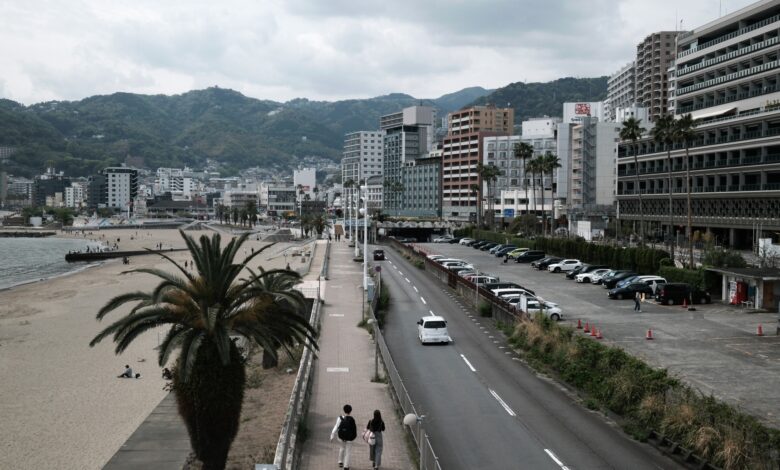Weaker yen keeps Japanese tourists at home while visitors throng

ONCE renowned as avid overseas tourists, the Japanese are staying closer to home these days.
A weaker yen, high air fares and tepid wage growth are keeping outbound travel stuck well below pre-pandemic levels. Just 1.22 million ventured abroad in March, 36.8 per cent less compared with the same period in 2019, according to the Japan National Tourism Organization. Meanwhile, a record number of tourists visited the island nation last month.
As Golden Week – Japan’s annual string of national holidays – gets underway this week, local travellers are opting for Kochi in the south, Atami near Tokyo and other popular spots such as Okinawa and Hokkaido. In response, Japan Airlines and ANA Holdings are allocating a big chunk of their seats to inbound travellers and profit-making regions with stronger demand. A recovery in outbound travel will not happen until next year at the earliest, according to the government.
“It might be some time before I travel abroad again; it’s overpriced now – food and everything,” said Tomoyo Shimoya, 39, who was celebrating her birthday at the Hatoya Hotel earlier this month because it was more affordable. An overnight stay with breakfast and dinner at the hotel, located a couple of hours from Tokyo, costs around 15,000 yen (S$129) per person. That compares with an average of US$375 per night for a hotel room in Hawaii.
Hatoya was a popular seaside destination during Japan’s postwar economic boom. It’s now enjoying a rebound after being overshadowed by glitzier resorts at home and abroad.
“Keeping our old image intact is a good thing,” said Shigeru Haraguchi, president of Fuji Shoji, which operates Hatoya and sister property Sun Hatoya. His grandfather bought the property in 1945 when it was a ryokan – a traditional inn – from a magician who performed magic tricks with pigeons, which are called hato in Japanese. “We will continue to provide food and services at just the right price and quality.”
GET BT IN YOUR INBOX DAILY

Start and end each day with the latest news stories and analyses delivered straight to your inbox.
Haraguchi expects Sun Hatoya’s occupation rate to be at 80 per cent during the upcoming Golden Week holidays. With their architecture mostly the same since they were built in the 1970s, the Hatoya hotels have become popular destinations for Instagrammers seeking retro vibes, with banquet halls, dinner shows and an aquarium-equipped hot spring.
Interest in local destinations has translated into a recovery in Japanese travellers’ spending within the country to pre-pandemic levels, to 21.9 trillion yen in 2023, government data showed. Along with robust inbound demand, with a record 3.1 million tourists visiting Japan in March, that’s driving up hotel prices to levels that have not been seen in three decades.
The average daily room rate last month was about 20,986 yen, the highest level since August 1997 and almost 20 per cent higher than the same period last year, according to CoStar Group.
Although ANA and Japan Airlines posted solid results in the fiscal third quarter, they are at risk of losing international market share, according to Bloomberg Intelligence analyst Eric Zhu. Lacklustre outbound travel “will likely constrain ANA and JAL’s profit potential this year with the duo needing to fight an uphill battle against foreign airlines for inbound visitors”, he said.
ANA is filling more seats on domestic routes during Golden Week, with the load factor up 3.8 percentage points from a year earlier. International flights showed a 0.9 point dip, according to reservation data from Japan’s biggest airline.
The lack of momentum in outbound travel is also reflected in the number of Japanese holding passports. Just 21.5 million, or 17 per cent of the population, held passports as at December, according to the Ministry of Foreign Affairs.
The government needs to urge people to get passports – some have called for lower fees and airlines have even offered to subsidise the costs – in order to encourage overseas travel, according to Masahiko Inada, director at the Japan Association of Travel Agents.
Eventually, outbound tourism will recover, with younger travellers visiting nearby countries during the recent spring vacation period, according to Inada. Agencies “are already receiving bookings for autumn and year-end”, he said. “I hope the trend continues.”
Mitsuko Tottori, chief executive officer of Japan Airlines, said last week that she’s worried younger people will venture less outside Japan because of the weaker yen. Koji Shibata, ANA’s CEO, also voiced similar concerns.
“We often discuss that the yen at the 130 level will be good,” Tottori said in a group interview last week, before the yen slid to a fresh 34-year low of 156 to the US dollar. “It’s a big problem.” BLOOMBERG

